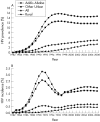HIV/AIDS in Ethiopia: where is the epidemic heading?
- PMID: 16581757
- PMCID: PMC2593072
- DOI: 10.1136/sti.2005.016592
HIV/AIDS in Ethiopia: where is the epidemic heading?
Abstract
Objectives: A possible decline in prevalence of HIV in some sub-Saharan African countries has been reported recently. The present study aimed to evaluate the prevalence and incidence of HIV and behavioural data to investigate trends in HIV/AIDS in Ethiopia.
Methods: A review was conducted of published reports and literature, raw and modelled (using Epidemic Projection Package and Spectrum software) surveillance data and estimates from antenatal clinics (ANCs) and data from voluntary counselling and testing centres. Observations were restricted to the adult population.
Results: Between 2001 and 2003, more ANC sites showed a decline than a rise in HIV prevalence, but most lacked statistical significance. Modelled data suggested a rise in prevalence of HIV in rural areas (2003: 2.6%) and in all Ethiopia (2003: 4.4%), but a stable or declining prevalence in Addis Ababa (2003: 14.6%) and other urban areas (2003: 11.8%). Modelled HIV incidence, inferred from prevalence changes, showed a slowly rising trend in Addis Ababa (2003: 2.0%), other urban areas (2003: 1.7%), and rural Ethiopia (2003: 0.46%). The total burden of HIV/AIDS is expected also to rise substantially due to population growth. In Addis Ababa, crude data on HIV prevalence from ANCs too suggested a falling trend. Voluntary counselling and testing data from 2002 to 2004 supported this trend but indicated a mixed trend pattern for high risk behaviour. No other serial behavioural trend data were available.
Conclusions: Lack of quality data on behavioural trends impedes the interpretation of prevalence and incidence data in Ethiopia. Modelled data suggest an expanding HIV epidemic in rural and all Ethiopia, but a possible decline in some urban areas. Crude site prevalence values may be more sensitive to acute changes, possibly indicating a slowing/reversal of the epidemic's expansion.
Conflict of interest statement
Competing interests: none declared
References
-
- Disease Prevention and Control Department AIDS in Ethiopia, 5th edn. Addis Ababa: Disease Prevention and Control Department, Ministry of Health 2005
-
- UNAIDS/WHO Working Group on Global HIV/AIDS/STI Surveillance Guidelines for conducting HIV sentinel serosurveys among pregnant women and other groups. Geneva: UNAIDS/WHO Working Group on Global HIV/AIDS/STI Surveillance, 2003
-
- Disease Prevention and Control Department AIDS in Ethiopia, 5th edn. Technical Document. Addis Ababa: Disease Prevention and Control Department, Ministry of Health, 2005
Publication types
MeSH terms
LinkOut - more resources
Full Text Sources
Medical

